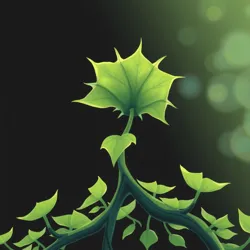Song of the Leaves

The Song of the Leaves is a traditional musical expression deeply embedded in the culture of the Arborian Epoch. This unique art form is performed by the Arborians, a civilization of sentient flora, who use the natural rustling of leaves to create harmonious melodies. The song serves as a medium for communication, celebration, and reflection, embodying the Arboreals' profound connection to their environment.
Origins and Significance
The origins of the Song of the Leaves are believed to date back to the early days of the Verdant Chronicles, when the Arboreals began to explore complex forms of communication beyond chemical signals. By harnessing the natural sounds produced by their leaves, they developed a sophisticated method of conveying emotions and ideas, which became an integral part of their cultural heritage.
The song holds significant spiritual and communal importance. It is often performed during key events such as the Pollination Festival and the unveiling of new root network maps. Through the Song of the Leaves, the Arboreals celebrate the changing seasons, commemorate historical events, and express their gratitude for the symbiotic relationships that sustain their society.
Composition and Performance
The composition of the Song of the Leaves is a collaborative effort, involving multiple plants harmonizing their leaf movements to produce a cohesive melody. The performance is typically enhanced by the presence of bioluminescent flora, which provide a visual accompaniment to the auditory experience.
Each performance is unique, as it is influenced by environmental factors such as wind patterns, sunlight, and the presence of pollinators. This dynamic nature reflects the Arboreals' appreciation for the ever-changing landscape of their world and their ability to adapt and thrive within it.
Cultural Impact
The Song of the Leaves is more than just a musical tradition; it is a symbol of the Arboreals' innovative spirit and their deep-rooted values. The song has inspired numerous artistic endeavors, including light and shadow art and scent-based performances, which further explore the interplay between nature and creativity.
In addition, the song plays a crucial role in the governance of the Arboreal society. It is often used during meetings of the Floral Council to facilitate peaceful discussions and foster a sense of unity among the council members.
Legacy and Modern Interpretations
The legacy of the Song of the Leaves endures in modern Arboreal society, where it continues to be a source of inspiration and cultural pride. Contemporary interpretations of the song incorporate advancements in photosynthetic technology, allowing for more intricate compositions and performances.
Today, the Song of the Leaves remains a cherished tradition, representing the Arboreals' unwavering connection to their environment and their commitment to preserving the harmony and balance of their world.
See Also
- Arborian Epoch
- Verdant Chronicles
- Pollination Festival
- Floral Council
- Root Network Maps
References
- "The Music of the Leaves: An Exploration of Arboreal Artistry" - Journal of Arboreal Studies.
- The Verdant Chronicles: Cultural Practices of the Arborians.
- Studies on the Impact of Environmental Factors on the Song of the Leaves.